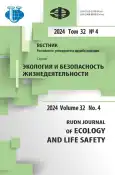Trace element composition of snow cover components in the city of Chita and its environs
- 作者: Bondarevich E.A.1
-
隶属关系:
- Chita State Medical Academy
- 期: 卷 32, 编号 4 (2024)
- 页面: 445-453
- 栏目: Environmental Monitoring
- URL: https://journal-vniispk.ru/2313-2310/article/view/324069
- DOI: https://doi.org/10.22363/2313-2310-2024-32-4-445-453
- EDN: https://elibrary.ru/NKPIVN
- ID: 324069
如何引用文章
详细
The variation in the concentrations of chemical elements of snow cover in melt water and native dust in the urbanized area of Chita and its environs was studied in comparison with the background area and literature data from other regions of Russia and Mongolia. The study of the accumulation of compounds of chemical elements in the components of snow cover makes it possible to assess the degree of pollution of the surface layer of the atmosphere under technogenesis conditions and to identify key sources of pollution. The goal of the work was to compare the amounts of a number of microelements in melted snow water and in native dust residue in areas of different degrees of technogenic load. The materials were dust and snow meltwater, in which the quantitative content of 22 chemical elements was determined using the X-ray fluorescence method of total external reflection on an S2 Picofox spectrometer (Bruker Nano GmbH, Germany). A low content of ionic forms of elements in the aqueous phase of snow was revealed, with an excess of the maximum permissible concentration for Mn by 1.5-2 times under technogenesis conditions. The concentrations of water-soluble forms of trace elements were comparable to data from other regions. The dust fraction of snow, on the contrary, was characterized by significant contamination with sparingly soluble forms of chemical elements, while no excess of the maximum permissible concentration / approximately permissible concentration was noted, and in comparison with the clarke for soils of populated areas, a slight excess of the content of As, Sn and W was noted. The dust fraction of the Chita snow cover, compared to the background, is enriched in Th, Rb, Cr and Ga; in the Chita region, intensive accumulation of Cr, As and Sr in the dust was revealed. Significantly larger amounts of microelements compared to Transbaikal samples were detected for the cities of Ulaanbaatar, Blagoveshchensk, and in somewhat smaller quantities Tyumen and Tobolsk. The mass fraction of water-soluble forms for most microelements was significantly less than 0.1%, while a tendency was revealed to increase the number of ionic forms of elements from the urbanized area to the background areas.
作者简介
Evgeniy Bondarevich
Chita State Medical Academy
编辑信件的主要联系方式.
Email: bondarevich84@mail.ru
ORCID iD: 0000-0002-0032-3155
Candidate of Biological Sciences, Associate Professor, Associate Professor of the Department of Chemistry and Biochemistry
39a St. Gorky, Chita, 672000, Russian Federation参考
- Alekseenko VA, Alekseenko AV. Chemical elements in geochemical systems. Clarks of soils of residential landscapes. Rostov-on-Don: Southern Federal University; 2013. p. 254-257. (In Russ.).
- Pavlov VE, Sutorikhin IA, Khvostov IV, Zinchenko GS. Snow cover as an indicator of pollution in the urbanized territory of the Altai Territory. Optics of the atmosphere and ocean. 2009;22(01):96-100. (In Russ.).
- Pavlova LM, Radomskaya VI, Yusupov DV. Highly toxic elements in the snow cover in the city of Blagoveshchensk. Geoecology. Engineering geology, hydrogeology, geocryology. 2015;(1):27-35. (In Russ.).
- Kuimova NG, Sergeeva AG, Shumilova LP, Pavlova LM, Borisova IG. Ecological and geochemical assessment of aerotechnogenic pollution of an urbanized area based on the state of snow cover. Geoecology. Engineering geology, hydrogeology, geocryology. 2012;(5):422-435. (In Russ.).
- Chagina NB, Aivazova EA, Ivanchenko NL, Varakin EA Analysis of snow cover in roadside areas of Arkhangelsk. Bulletin of the Northern (Arctic) Federal University. Series: Natural Sciences. 2015;(2);129-141. (In Russ.).
- Kosheleva NE, Kasimov NS, Sorokina OI, Gunin PD, Bazha SN, Enkh-Amgalan S. Geochemistry of Ulaanbaatar landscapes. News of the Russian Academy of Sciences. Geographical series. 2013;(5):109-124. (In Russ.).
- Tasool LH, Yanchat NN, Zhdanok AI, Chupikova SA. Pollution of snow cover in the territory of Kyzyl. Geoecology. Engineering geology, hydrogeology, geocryology. 2014;(6):507-517. (In Russ.).
- Belozertseva IA, Vorobyeva IB, Vlasova NV, Lopatina DN, Yanchuk MS. Snow pollution in lake Baikal water area in nearby land areas. Water Resources. 2017; 44(3):471-484. (In Russ.). https://doi.org/10.7868/S032105961703004X
- Ermolov YuV, Makhatkov ID, Khudyaev SA. Background concentration of chemical elements in snow cover of the typical regions of the Western Siberia. Optics of the atmosphere and ocean. 2014;27(09):790-800. (In Russ.).
- Bondarevich E, Kotsurzhinskaya N, Leskova O, Mikhailova L, Samoylenko G. Monitoring the Level of the Air Contamination by Chemical Elements Impoundment in the Snow Melt of the Snow Blanket. Ecology and Industry of Russia. 2021;25(8):47-53. (In Russ.). https://doi.org/10.18412/1816-0395-2021-8-47-53
- Papina TS, Eirikh AN, Malygina NS, Eyrikh SS, Ostanin OV, Yashina TV. Microelement and stable isotopic composition of snowpack in the Katunsky biosphere reserve (Altai Republic). Ice and Snow. 2018;58(1):41-55. (In Russ.). https://doi.org/10.15356/2076-6734-2018-1-41-55
- Zakharchenko AV., Tigeev AA. Microelements in Dust in the Snow Cover: a Case Study of the Cities of Tyumen and Tobolsk. Ice and Snow. 2023;63(3):397-409. (In Russ.). https://doi.org/10.31857/S2076673423030146
补充文件









